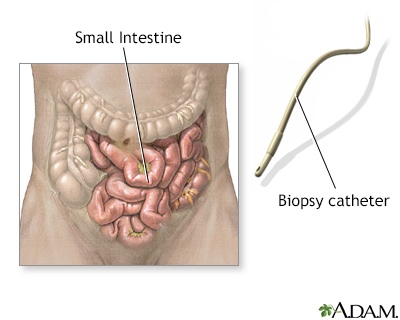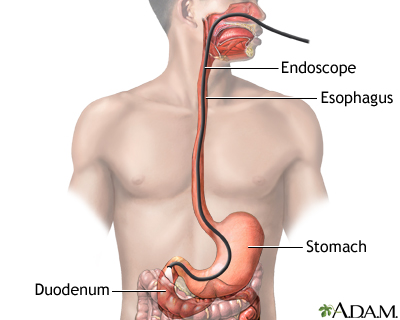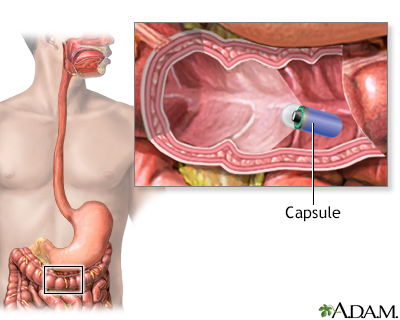Enteroscopy
Push enteroscopy; Double-balloon enteroscopy; Single-balloon enteroscopy; Spiral enteroscopy; Capsule enteroscopy
Enteroscopy is a procedure used to examine the small intestine (small bowel).
Images



I Would Like to Learn About:
How the Test is Performed
An enteroscope uses a long flexible tube with a balloon and a camera attached that can go deep down the inside of the small bowel.
During a single- or double-balloon enteroscopy, balloons attached to the endoscope can be inflated to allow the doctor to view a section of the small intestine. The enteroscope is usually inserted through the mouth for upper enteroscopy.
In a colonoscopy, a flexible tube is inserted through your rectum and colon. The tube can most often reach into the end part of the small intestine (ileum). Occasionally, an enteroscope is inserted through the rectum to reach further into the end of the small intestine.
Capsule endoscopy is done with a disposable capsule that you swallow. This transmits pictures to a recorder and is uploaded to a computer for viewing the pictures.
Tissue samples removed during enteroscopy are sent to the lab for examination. (Biopsies cannot be taken with a capsule endoscopy.)
How to Prepare for the Test
Tell the doctor doing your enteroscopy if you take blood thinners such as warfarin (Coumadin), clopidogrel (Plavix), apixaban (Eliquis), aspirin, or daily NSAIDs because these may interfere with the test. Do not stop taking any medicine unless told to do so by your doctor or health care provider.
Do not eat any solid foods or milk products after midnight on the day of your procedure. You may have clear liquids until 4 hours before your exam. Occasionally a laxative is given before the enteroscopy. Follow your specific instructions.
You must sign a consent form.
How the Test will Feel
You will be given calming and sedating medicine for the procedure and will not feel any discomfort. You may have some bloating or cramping when you wake up. This is from air that is pumped into the abdomen to expand the area during the procedure.
A capsule endoscopy causes no discomfort.
Why the Test is Performed
This test is most often performed to help diagnose diseases of the small intestine. It may be done if you have:
- Abnormal x-ray results
- Tumors in the small intestine
- Unexplained diarrhea
- Unexplained gastrointestinal bleeding
Normal Results
In a normal test result, the doctor will not find sources of bleeding in the small bowel, and will not find any tumors or other abnormal tissue.
What Abnormal Results Mean
Abnormal signs during an enteroscopy may include:
- Abnormalities of the tissue lining the small intestine (mucosa) or the tiny, finger-like projections on the surface of the small intestine (villi)
- Abnormal lengthening of blood vessels (angioectasia) in the intestinal lining
- Immune cells called PAS-positive macrophages
- Polyps or cancer
- Radiation enteritis
- Swollen or enlarged lymph nodes or lymphatic vessels
- Ulcers
Changes found on enteroscopy may be signs of disorders and conditions, including:
- Amyloidosis
- Celiac disease
- Crohn disease
- Folate or vitamin B12 deficiency
- Giardiasis
- Infectious gastroenteritis
- Lymphangiectasia
- Lymphoma
- Small intestinal angioectasia
- Small intestinal cancer
- Tropical sprue
- Whipple disease
Risks
Complications are rare but may include:
- Excessive bleeding from the biopsy site
- Hole in the bowel (bowel perforation)
- Infection of the biopsy site leading to bacteremia (bacteria in the bloodstream)
- Vomiting, followed by aspiration into the lungs
- The capsule endoscope can cause a blockage in a narrowed intestine with symptoms of abdominal pain and bloating
Considerations
Factors that prohibit use of this test may include:
- Uncooperative or confused person
- Untreated blood clotting (coagulation) disorders
- Use of medicines that prevent the blood from clotting normally (anticoagulants)
The greatest risk is bleeding. Signs of bleeding include:
Related Information
Radiation enteritisSwollen lymph nodes
Celiac disease – sprue
Valley fever
Folic acid in diet
Vitamin B12
Giardia infection
Viral gastroenteritis (stomach flu)
Crohn disease
Lymphadenitis
Hodgkin lymphoma
Tropical sprue
Whipple disease
Lactose intolerance
References
Cameron J. Large bowel. In: Cameron J, ed. Current Surgical Therapy. 14th ed. Philadelphia, PA: Elsevier; 2023:177-286.
Rojas I, Barth B. Capsule endoscopy and small bowel enteroscopy. In: Wyllie R, Hyams JS, Kay M, eds. Pediatric Gastrointestinal and Liver Disease. 6th ed. Philadelphia, PA: Elsevier; 2021:chap 63.
Sugumar A, Vargo JJ. Preparation for and complications of gastrointestinal endoscopy. In: Feldman M, Friedman LS, Brandt LJ, eds. Sleisenger and Fordtran's Gastrointestinal and Liver Disease. 11th ed. Philadelphia, PA: Elsevier; 2021:chap 42.
Waterman M, Zurad EG, Gralnek IM. Video capsule endoscopy. In: Fowler GC, ed. Pfenninger and Fowler's Procedures for Primary Care. 4th ed. Philadelphia, PA: Elsevier; 2020:chap 93.
BACK TO TOPReview Date: 12/31/2023
Reviewed By: Jenifer K. Lehrer, MD, Department of Gastroenterology, Aria - Jefferson Health Torresdale, Jefferson Digestive Diseases Network, Philadelphia, PA. Review provided by VeriMed Healthcare Network. Also reviewed by David C. Dugdale, MD, Medical Director, Brenda Conaway, Editorial Director, and the A.D.A.M. Editorial team.

Health Content Provider
06/01/2025
|
A.D.A.M., Inc. is accredited by URAC, for Health Content Provider (www.urac.org). URAC's accreditation program is an independent audit to verify that A.D.A.M. follows rigorous standards of quality and accountability. A.D.A.M. is among the first to achieve this important distinction for online health information and services. Learn more about A.D.A.M.'s editorial policy, editorial process and privacy policy. A.D.A.M. is also a founding member of Hi-Ethics. This site complied with the HONcode standard for trustworthy health information from 1995 to 2022, after which HON (Health On the Net, a not-for-profit organization that promoted transparent and reliable health information online) was discontinued. |
The information provided herein should not be used during any medical emergency or for the diagnosis or treatment of any medical condition. A licensed medical professional should be consulted for diagnosis and treatment of any and all medical conditions. Links to other sites are provided for information only -- they do not constitute endorsements of those other sites. © 1997- 2025 A.D.A.M., a business unit of Ebix, Inc. Any duplication or distribution of the information contained herein is strictly prohibited.
